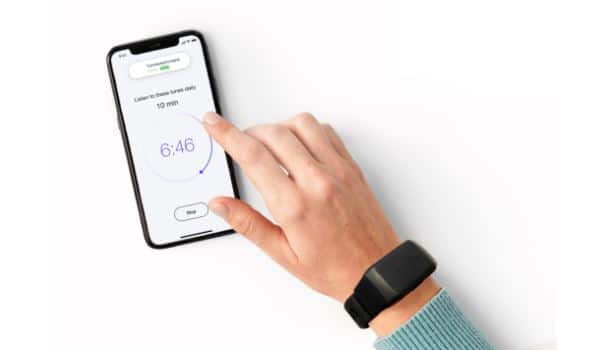Neosensory, a California-based startup founded by Stanford neuroscientist Dr. David Eagleman and neuroengineer Dr. Scott Novich, is now offering a hardware-based tinnitus program called Neosensory Duo.
The Duo takes a unique approach to address tinnitus, which is estimated to impact 10 to 15% of adults in the United States. Global estimates suggest as many as 1.6 billion people have dealt with tinnitus in their lives.
Tinnitus refers to the perception of sound without any external source and can take many forms and frequencies — from ringing to buzzing to hissing to roaring — which can be constant or intermittent in nature.
Bimodal Stimulation: New Applications for Tinnitus
Neosensory’s new Duo solution leverages recent scientific advancements in the field of “bimodal stimulation” — that is, stimulating the brain via synchronized sound and vibration on the skin.
The effectiveness of the bimodal stimulation concept in tinnitus sufferers has been demonstrated in trials conducted by separate teams at the University of Michigan and Trinity College, Dublin.
How Does it Work?
Neosensory’s haptic wristband creates vibrational patterns on the skin via the band’s four motors and pairs them with synchronized tones picked up by the user’s ears. According to the company, the proprietary, noninvasive method “leverages the principles of neuroplasticity and reduces tinnitus symptoms in 87% of users”.

During the eight-week training program, the vibrating wristband is worn while listening to a series of customized musical notes through Neosensory’s app.
The company’s research recommends 10 minutes of listening per day for 2 months, with the option to keep the wristband for longer use. The program is based on a subscription model of $249 a month.
Leveraging Neuroscience Research to Address Tinnitus
“Our research on neuroplasticity spans two decades. Advancements in both neuroscience and engineering have enabled my team at Neosensory to make this noninvasive program available to the public,” says Dr. Eagleman, the CEO of Neosensory. Eagleman teaches at Stanford University, is a Pulitzer prize nominated author, and is the presenter of the Emmy-nominated PBS series The Brain.
Eagleman founded Neosensory in 2015 alongside his then-PhD student and current Neosensory CTO Dr. Scott Novich.
“Our research began with the idea that our experience of reality can go beyond our sensory limitations. Our team is inspired by the transformative technology we are building, and we’re dedicated to making a meaningful social impact with our sound-to-touch products.”
–David Eagleman, Ph.D., CEO of Neosensory
Neosensory made a splash in the world of auditory technology when the California-based start-up introduced its sensory substitution device, Buzz, in March 2020. The wristband, fitted with four vibrating motors, picks up sound around the wearer and translates it into unique vibrational patterns. Over time, the brain learns to interpret the vibrations and allows Deaf and hard-of-hearing individuals to be more aware of their surroundings.
In the future, Neosensory is set to expand its technology beyond hearing-related topics. “The overarching goal of our work is to better understand how sensory streams can be re-packaged into atypical sensory channels to restore perception or give new perceptions,” Eagleman said. “Beyond applications for hearing, our devices can send any kinds of information to the brain for sensory processing via atypical sensory channels”
Opinions from Audiologists
 Currently, the Neosensory Duo is the only program utilizing bimodal stimulation available on the US market. Audiologist Dr. Ben Thompson, who specializes in tinnitus care, reviewed Neosensory’s device for both its sound awareness and tinnitus functions.
Currently, the Neosensory Duo is the only program utilizing bimodal stimulation available on the US market. Audiologist Dr. Ben Thompson, who specializes in tinnitus care, reviewed Neosensory’s device for both its sound awareness and tinnitus functions.
“I was experiencing the bimodal stimulation in a very non-invasive way and it was my first time getting a true experience of what that would feel like,” Thompson said in his video review. “I didn’t feel like it was a distraction or annoying.”
He described the sensation of listening to the tones and simultaneously feeling the vibrations on his wrist as calming and comfortable. “I liked it so much that I kept listening to it with sound around me, so it was almost like an additional way to promote sound therapy in my environment, ” said Thompson.
Since testing the device, Thompson has joined Neosensory to offer specialist consultations as part of Duo Pro, a comprehensive package combining Neosensory’s tinnitus program and personalized healthcare.
“I notice my tinnitus less. It’s easier to let it fade into the background”
–Study participant
At least two new Neosensory products are currently in the works, but Eagleman said neurotech fans will have to wait until a Stanford University study is wrapped up before making further announcements.
Neosensory Duo is available on Neosensory’s website.






